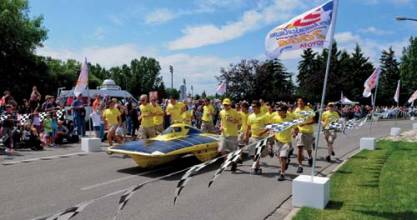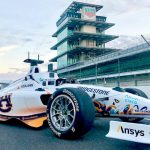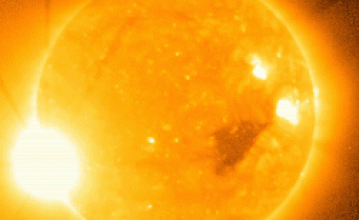Continuum, the University of Michigan’s solar car that raced 2,400 miles propelled by the amount of power used by a hair dryer, started out in Texas and never surrendered the lead until they reached their goal in Alberta, Canada, on July 22.
Continuum, the University of Michigan’s solar car that raced 2,400 miles propelled by the amount of power used by a hair dryer, started out in Texas and never surrendered the lead until they reached their goal in Alberta, Canada, on July 22.
But when did the five-time winners of the North American Solar Challenge 2008 (NASC 2008) decide it was a sure thing?
“I knew we had won when we crossed the finish line,” said Alex Dowling, head strategist for the space-age car built and driven by engineering students through the hot middle of North America. “Until then, I worried about an unforeseeable problem, such as a vehicle system failing. I didn’t count it as a victory until we crossed the finish line.”
Maintaining an average speed of about 46 miles per hour, the ultra-modern Continuum covered the distance from Plano, Texas, to Calgary, Alberta, in 51 hours, 41 minutes and 53 seconds. (See the sidebar, “The Race,” for more about NASC 2008.)
Solar Power
What does it take to propel a 650-pound car and driver on such a serious road trip? Well, the more sun the better for the car’s solar cells, which convert the small amount of solar energy that makes it through the atmosphere directly into electrical energy.
Located on the vehicle’s upper surface, the car’s solar array consists of 2,700 triple-junction gallium-arsenide solar cells — the same type found on satellite solar panels. Any energy generated by the solar array that is not used to drive the vehicle is stored in Continuum’s lithium-polymer batteries.
But it took more than sunlight to make a winner out of Continuum. It took planning, strategy, and close coordination among the race car driver, escort vehicles, and the University of Michigan support team — assisted in all three task by GPS positioning.
The Cloud Strategy
The Michigan team emphasized the importance of accurate GPS and route information to their success. “This helped us plan ahead and save extra energy in the battery for those nasty hills,” they said on their 2008 race blog.
About two months before the race, the Michigan students drove the route and surveyed it at a 10 Hz sampling rate using two donated, 20-channel L1 survey GPS receivers and a commercial satellite-based differential GPS (DGPS) service. Along the route, data such as latitude, longitude, quality of the GPS signal and heading were collected and stored on a laptop computer. The team also marked locations of hills, for later use in planning vehicle speeds.
The GPS receiver was not integrated with the computer used to record the route information. Instead, the GPS receiver output route data over an RS-232 (serial) connection to the laptop. The team developed software that records the GPS data onto its hard drive.
The DGPS service provider specifies a 10-centimeter real-time accuracy using its corrections, but the Michigan team didn’t need to verify these for the survey. “We care more about precision than accuracy for our application,” said Dowling. “If everything is off by one meter in the same direction, it doesn’t matter. We care about the differences in elevation.”
After the route survey, the GPS information was postprocessed using the team-developed software. The team overlapped the data from the route survey, which included coordinates of stop signs, speed limit changes, and so forth, into a digital mapbase. To help navigation during the race, a team member wrote a custom program inside of the mapping software to show the upcoming hazards on the race route, along with turn-by-turn directions and the location of other caravan vehicles.
The postprocessed data was also stored and used by the computer to run simulations during the race. Indeed, no fewer than three strategists, including Dowling, were running route simulations during the race.
These people rode in a “chase” car, the support vehicle following about 20 feet behind Continuum. Variables that the simulations took into account included radiation levels, cross-winds, grade of the road, current state of the vehicle’s battery, and weight of the vehicle. Sometimes multiple simulations were run using the same program, but with different weather patterns as inputs.
Dowling primarily used two simulation/optimization programs, each with different optimization algorithms that took into account various factors (one had more detail than the other) and took different amounts of time to run.
“I knew the advantages and shortcomings of each simulation technique and was able to make an educated guess about which simulation was closest to reality,” he said. With that information and other undisclosed inputs, Dowling was able to recommend a vehicle speed conducive to making the most efficient use of the available sunlight and stored energy in the battery.
The simulation and optimization software took into account the exact location of the vehicle.
Traveling the right speed at all times was a key to winning the race. Continuum couldn’t produce enough energy to run the entire distance at the speed limit, and the team faced a hard choice. If the car traveled fast under clouds, it risked drawing down too much battery power. On the other hand, running under clouds at the speed limit could help win the race and would move the car into sunny weather sooner, where it could gather more energy.
During the race, the GPS survey receiver was installed on the chase cars, but not on Continuum because it would have been extra weight on the vehicle. (It’s a race car, after all.)
The receiver was configured to output at 10 Hz and used a one-meter DGPS correction service during the race. The motor on Continuum contains a Hall Effect sensor that measured the speed of the vehicle.
Other support vehicles had simpler GPS navigation units on them. These units were used in conjunction with the navigation software described earlier to share the location of support vehicles with each other. This position data was transferred over the Internet using cellular Internet cards.
With the benefit of the GPS route survey, at any point in the race the team knew what terrain lay ahead of the race car and could budget Continuum’s energy better.
Dowling believes the Michigan strategy was superior to the other teams. “Lots of times we drove fast to get out of the clouds and were able to spend more time driving in the sun. Most of the other teams drove slowly in the clouds and were stuck under them for a longer period of time.”
Lead, Scout, Weather, and Chase
During the race, Continuum enjoyed the support of four escort vehicles. Running about a half-hour in front of the Michigan team, meteorology student Brad Charboneau transmitted weather forecasts from “Weather.” About 10 miles in front of Continuum, ”Scout” carried two relief solar car drivers and cleared the road of any foreign objects, including road kill, which might slow down or disable the ground-hugging solar car.
“Lead,” the vehicle carrying support engineering students, ran just in front of Continuum. Directly behind the solar car, “Chase” carried the three strategists, Michigan’s race manager Jeff Ferman, crew chief Doug Lambert, and an additional engineer as driver.
The team used two main modes of communication: radio or text-style messaging. The solar car driver had a radio for communications with the Lead and Chase vehicles. Lead and Chase could send text messages that appeared on a driver display. The driver then answered questions using “yes” and “no” buttons on the steering wheel.
Ferman said the Chase and Lead cars shared the same telemetry information, including speed of the solar vehicle, voltages and currents, and the battery pack reading. “Any power consumptions that we can read, we do read,” he said.
Under the Hood
Continuum runs on three wheels, like a large tricycle. The front wheel steers and drives the car.
The driver adjusts the vehicle’s speed using a throttle paddle (potentiometer) on the steering wheel — a small lever that can be depressed with the thumb. The vehicle’s electrical system processes this signal and adjusts the output of the vehicle’s motor according, which causes the vehicle to either accelerate, decelerate or maintain speed.
The team’s strategists also have the ability of sending a cruise-control command to the vehicle. If the driver accepts the new cruise control speed, the vehicle automatically adjusts. Continuum’s motor is also capable of regenerative braking. In addition, the vehicle has custom disk brakes.
During the race, teams drove from 8 a.m. until 6 p.m. each day over a 10-day period. In the morning and evening, they were permitted to charge their main battery using only their solar array. Continuum was very competitive in almost every area, said Dowling, with an efficient battery pack and electric motor, a powerful solar array, and an aerodynamic body.
The car had already competed in the World Solar Challenge held during the summer of 2007 in Australia. It had finished seventh, despite a serious accident on the first day.
“Our team spent the past year perfecting the car while other teams were still building their vehicles,“ Dowling said, “So, Continuum was very reliable, and we spent only minimal time on the side of the road during the race.”
About the Race
Fifteen solar cars from universities in the U.S., Canada, and Germany completed in North American Solar Challenge (NASC) 2008, sponsored this year by Toyota, the DNA Group, and Crowder College Missouri Alternative and Renewable Energy Technology (MARET) Center.
The 18-year-old event is designed to inspire young people to pursue careers in science and engineering. And with each race, the solar cars travel faster and further with greater reliability.
NASC’s predecessors, the American Solar Challenge and Sunrayce, were underwritten by the U.S. Department of Energy until funding was cut in 2005. The race generally has been held every two years since 1990.
This year, the race was run in five stages over the course of 10 days. The University of Michigan, whose team is profiled here, is a seasoned veteran of the competition. The 2008 winner, Continuum, is their ninth solar-powered vehicle. It beat the second-place entry — Ra 7 from Principia College in Illinois — by 10 hours.






